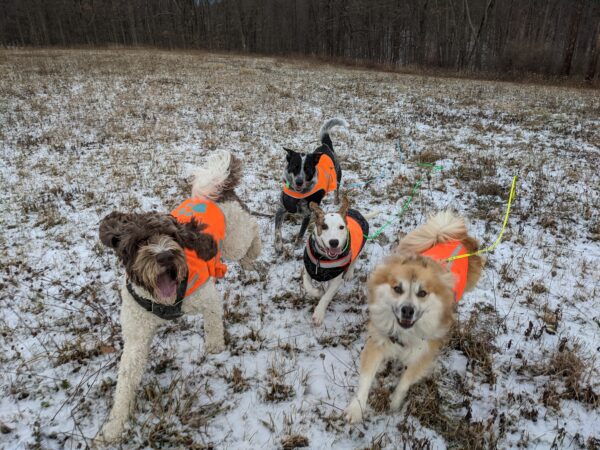BARKS from the Guild
Stimulation for Psittacines
By Amy Martin Physical and mental stimulation is vital to every species on the planet. Squid, poison dart frogs, pigs, rats, cats, tortoises, spiders, jaguars, sheep, dogs, ferrets, parrots, you name it, they all need daily stimulation. Enrichment is a fundamental component of responsible, preventative companion parrot care. But how can we ensure the parrots we care for are getting enough? Vital For Well-Being Studies have shown that when animals are provided with a stimulating environment, they are less stressed, live longer and are better able to develop problem-solving skills,… Continued
The Problem with “Furry Little Humans”
By Andrea Carne Let’s open this discussion with the whole cats vs. dogs “thing.” Honestly, why do we continue to debate this ongoing battle of the species? Social media is filled with cartoons and memes depicting the supposedly obvious differences and, while I can enjoy the funny side as much as anyone else, there is a serious side to the argument when it comes to actual research. Case in point: A new study by Chijiiwa et al. (2021) on cat behavior has already gained a lot of press this year,… Continued
Lessons in Empathy
By Kathy Wolff According to Wikipedia (2021), empathy is the “capacity to understand or feel what another person is experiencing from within their frame of reference, that is, the capacity to place oneself in another’s position. Definitions of empathy encompass a broad range of emotional states.” “Hi, my name is Kathy, and I’m a Nervous Nellie.” At least, that’s the cutsie polite little name we used to call it when I was younger. I was someone who always saw the glass half empty, worried about what was going to happen… Continued
Case Study: From Reactive to Relaxed
By Dr. Sheryl L. Walker Of all my years studying animal behavior and consulting with individual clients and animal shelters, there was one case in particular that stood out, partly because it featured two incredibly dedicated guardians. Ironically, it was also one of my most complex cases. It was a case of canine anxiety- and pain-induced dog-directed aggression involving a young neutered male named Gerhardt who had approximately six bite events between August 2009 and November 2012, beginning when he was approximately 7 months old. The environmental trigger, initially, seemed… Continued
It’s All in the Management
By Dr. Morag Heirs When you are dealing with a deaf puppy or an adolescent deaf dog in a rescue environment, mouthing and nipping is often high on the list of problem behaviors. Do deaf dogs and puppies mouth, nip or grab more than hearing dogs? The honest answer here is that we just do not know. Anecdotally, based on the requests for help we see on forums and websites, mouthing, nipping and/or grabbing does not seem to be more of a problem for deaf dogs than it is with… Continued
Empowerment for a Better Quality of Life
By Miki Saito When looking after a blind dog, it is vital to know his abilities as well as his challenges so we do not limit his world any more than necessary. Blind dogs still need to explore and achieve things on their own. All we have to do is set up their environment differently and approach training in a new way to ensure their safety. We need to consider the potential frustration, confusion and fear caused by the loss of vision. With this in mind we need to help… Continued
Playing It Safe
By Andrea Carne “Play with your cat more – and give him a meaty diet…” I wouldn’t be surprised if variations on this kind of advice has been given by vets and cat behavior consultants over the eons. And indeed, in addition to being supportive of feline well-being in general, a new study suggests it could also reduce hunting behavior and, perhaps more importantly for many cat guardians, reduce the number of prey animals brought home as unwanted “gifts.” The study, conducted by Martina Cecchetti and colleagues from the University… Continued
Alone Training
By Don Hanson Dogs are social animals, and most will actively seek out our companionship. They can quickly become accustomed to having their people around all the time (especially during these pandemic times when many of us are spending more time at home than usual), but this is not a necessarily good thing if they will need to spend some time on their own at some stage. And as much as we might want to believe we will always be with our dogs all the time, that scenario is improbable.… Continued
Play vs. Aggression
By Maureen Tay As a trainer, the issue of aggression is raised a lot. Indeed, it is the most commonly reported behavior issue by dog owners (Overall, 2013). One owner who contacted me recently had adopted a new dog and called me to say that the new dog and the resident dog were now growling at each other and going after each other’s legs and necks. But without being there to see the actual situation, it is obviously impossible to tell if these dogs are just playing or if there… Continued
The Porcine Phenomenon
By Lara Joseph As we all know, animals are fascinating, especially when it comes to their ability to learn and their individuality. I am attracted to intelligent animals who learn quickly and are able to change their behavior to get a new outcome, for example, the pig, the vulture, the parrot and the octopus. I train many animals and am often asked to train pigs. The rate at which a young, healthy pig who lives in an enriched environment can learn often stuns people, including the professional trainer. This rate… Continued
A Positive Strategy
By Tamsin Durston As I set up my dog on the start line of an agility course, I want her to feel excited and exhilarated. At the same time, I also want her to feel relaxed within the environment and completely engaged with me, focused on my communication and maintaining our connection throughout this adventure together. In human psychology we talk about ‘flow’ as being ‘in the zone,’ i.e. giving the task at hand our full attention, oblivious to whatever else is happening. Flow is also what we want to achieve… Continued
A New Trend in Dog Boarding
By Rachel Brix Pioneered by Dr. Hal Markowitz in the 1960s, enrichment originated from a focus on zoo animals. He called zoos “concrete wastelands” (Bender & Strong, 2019) and was determined to improve the animals’ lives in captivity. He first developed ethograms, or inventories of behaviors, for each species; then, after determining the animals’ needs, came the task of how to meet those needs in captivity. Our pet dogs, although not captive wild animals, still have instinctual and natural behaviors. Although domestication has softened many of these behaviors, as we… Continued
Life Beyond Leash Reactivity
As far as behavior consults go, it’s fair to say that reactivity is probably my most commonly encountered issue. The term ‘reactivity’ has become, I feel somewhat of a buzzword over recent years but what I’m referring to in this post is dogs who are reactive on the leash when they encounter unfamiliar dogs. Symptoms might include vocalization (barking, whining, howling, growling, yapping for example), lunging, pulling and straining, wild and frantic spinning, attempts to bolt and multifarious postural displays – from the very subtle to the overt. Some dogs… Continued

The Essence of a Dog: A Free Education from a Free Choice Walk
By Kristi Benson One cold day last spring, snow still clinging to the ground and ceding to the warm sun only on the tips of south-facing hillocks, I decided to do something new. I wouldn’t walk my dogs; nor would I walk with my dogs. I would instead be walked by my dogs. I decided to simply follow my dog Mischa for our whole walk. Wherever he chose to go, well, I’d go just the same. I crawled under logs, I lumbered across frozen wetlands sinking thigh-deep into the granular… Continued
A Safe Escape
By Dr. Lisel O’Dwyer The Adelaide Hills, South Australia have recently faced severe brushfires, an unfortunate situation that has prompted the discussion of the logistical differences between evacuating and housing horses versus dogs and other small domestic pets in the face of natural disasters such as brushfires and floods. The most obvious difference between evacuating dogs and horses is that it is, of course, much easier to evacuate dogs. The average horse owner can only transport his or her horse(s) with a horse float (also known as a horse trailer… Continued
The Itch to Scratch
By Andrea Carne Regardless of whichever behavior issue I have been called upon to assist a cat guardian with – whether it be inappropriate toileting, aggression towards humans, or aggression between cats in a multicat household – I can almost guarantee that when I ask at the end of a consult, “Is there anything else you wanted to chat about while I’m here?”, the response will always include some variation of, “How do I get them to stop scratching the furniture?” My first response is generally to explain that scratching… Continued
Navigating the Storm
By Mary Jean Alsina “I’m not afraid of storms, for I’m learning how to sail my ship.” – Louisa May Alcott Many dogs who come into this world quickly learn that there are many storms of which to be afraid. These storms come in many guises: other dogs, bearded men, men in general, vacuum cleaners, leaves rustling, visits to the vet and a whole myriad of other spooky things. Fearful dogs see the world around them as a very unsafe environment in which to live, relax and enjoy the lives… Continued
A Cautionary Tale
By Kayla Sprague Before entering the world of dog training I had never really had an opinion on shock collars. To me they were just another kind of collar, another way to train a dog. I was unaware of any negative effects. After studying more about positive reinforcement training, however, I began to see another side to them as I realized exactly what they did and how they worked. It made me think about how this type of collar can mentally, physically and emotionally affect a dog. Then, on September… Continued
Straight from the Horse’s Mouth
By Dorothy Heffernan With a growing interest in ‘least intrusive, minimally aversive’ (LIMA) training methods and the ‘least intrusive effective behavior intervention’ (LIEBI) model, many equestrians of today are increasingly starting to consider the option of riding their horses without using a bit. Bits have traditionally been used to train and control horses, but few people question why this might be, or how they actually work. But there isn’t really a single answer to this “why,” because different cultures have their own approaches towards horse training. One single fact is… Continued
Trick Bunnies
By Emily Cassell “So, where do you plan to hold your trick classes?” asked the interviewer from Do More with Your Dog! I hoped she was ready for the answer: “I don’t actually plan to hold in-person classes,” I explained. “The reason I am trying to get certified is so that I can create a Spark group for bunnies.” If you aren’t familiar with Do More with Your Dog! or their trick titling program, let me fill in some gaps for you. Do More with Your Dog! was the first sanctioning… Continued
That Lightbulb Moment
By Bob McMillan Most of us have had that “ah- ha!” moment when we look at a dog and suddenly see more than a drooling collection of fur, bright eyes and animals instincts; when we realize here is a creature of another species who has feelings, intelligence, a sense of fair play and is very much self-aware. We are no longer looking at a shaggy lump, and this is no fanciful talking cartoon character. We are looking into the eyes of “The Other.” It may be a gradual realization. It… Continued
Ask the Dog!
By Ada Simms Many dog trainers and dog owners probably have a closet full of front attaching or no-pull harnesses. It shows that our interest is about the dogs and their comfort, therefore we experiment. Could we find one that goes on easier or one that provides more control yet is still comfortable for the dog? As I thought about whether I should use brand names or not for this article, I came to the conclusion I would not be doing justice to the companies that I have not bought… Continued
Itchy Dog or Stressed Dog?
By Dr. Naomi D. Harvey The relationship between stress, behavior and animal health is complex and varied. Chronic, long-term stress interacts in various ways with personality type, behavior and immune health in both people and nonhuman animals. It’s not often straightforward to decipher which causes which when we evaluate chronic stress and health, however. Links between Stress, Behavior and Health An animal’s behavior can impact aspects of its physiology, such as its immune system, and conversely, the animal’s physiology and immune system can affect its behavior. According to Lopes (2017)… Continued
It’s a Dog’s Life
By Cecilia Sumner Not surprisingly, I love living with dogs. I embrace their essential dogginess. Barking, jumping, digging, hunting, these are all normal canine behaviors. I recognize I need to provide an outlet for these behaviors to keep my dogs happy and stress-free. Many pet owners struggle with understanding their dogs’ behavioral needs. While dogs evolved alongside humans, in recent history, our environment and expectations of our dogs have changed. Increasingly we fit our dogs into small compartments in our lives, often rendering us unable to allow them an appropriate… Continued
« Previous 1 2 3 4 5 Next »

